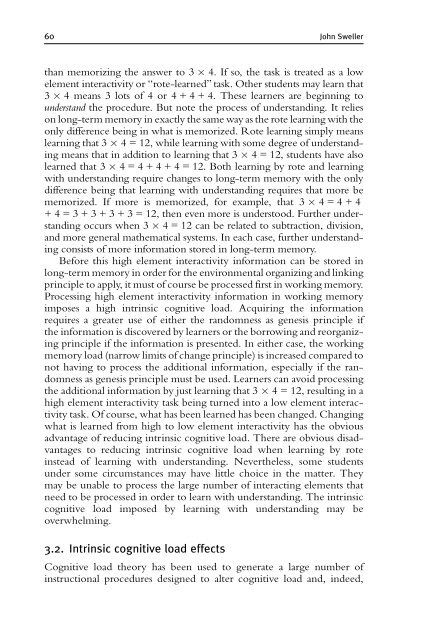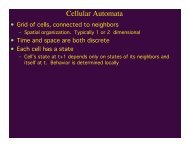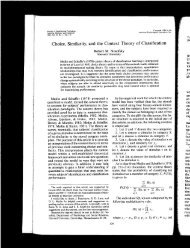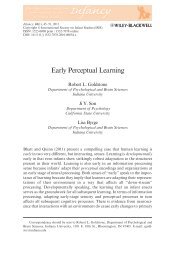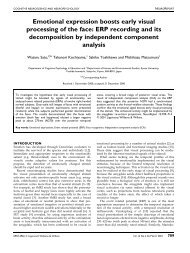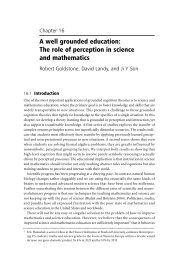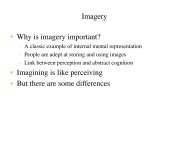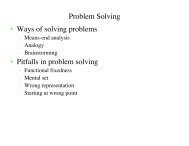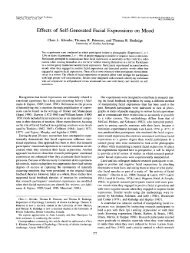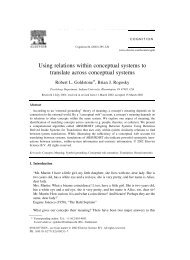the psychology of learning and motivation - Percepts and Concepts ...
the psychology of learning and motivation - Percepts and Concepts ...
the psychology of learning and motivation - Percepts and Concepts ...
You also want an ePaper? Increase the reach of your titles
YUMPU automatically turns print PDFs into web optimized ePapers that Google loves.
60 John Swellerthan memorizing <strong>the</strong> answer to 3 4. If so, <strong>the</strong> task is treated as a lowelement interactivity or ‘‘rote-learned’’ task. O<strong>the</strong>r students may learn that3 4 means 3 lots <strong>of</strong> 4 or 4 + 4 + 4. These learners are beginning tounderst<strong>and</strong> <strong>the</strong> procedure. But note <strong>the</strong> process <strong>of</strong> underst<strong>and</strong>ing. It relieson long-term memory in exactly <strong>the</strong> same way as <strong>the</strong> rote <strong>learning</strong> with <strong>the</strong>only difference being in what is memorized. Rote <strong>learning</strong> simply means<strong>learning</strong> that 3 4 = 12, while <strong>learning</strong> with some degree <strong>of</strong> underst<strong>and</strong>ingmeans that in addition to <strong>learning</strong> that 3 4 = 12, students have alsolearned that 3 4 = 4 + 4 + 4 = 12. Both <strong>learning</strong> by rote <strong>and</strong> <strong>learning</strong>with underst<strong>and</strong>ing require changes to long-term memory with <strong>the</strong> onlydifference being that <strong>learning</strong> with underst<strong>and</strong>ing requires that more bememorized. If more is memorized, for example, that 3 4=4+4+ 4 = 3 + 3 + 3 + 3 = 12, <strong>the</strong>n even more is understood. Fur<strong>the</strong>r underst<strong>and</strong>ingoccurs when 3 4 = 12 can be related to subtraction, division,<strong>and</strong> more general ma<strong>the</strong>matical systems. In each case, fur<strong>the</strong>r underst<strong>and</strong>ingconsists <strong>of</strong> more information stored in long-term memory.Before this high element interactivity information can be stored inlong-term memory in order for <strong>the</strong> environmental organizing <strong>and</strong> linkingprinciple to apply, it must <strong>of</strong> course be processed first in working memory.Processing high element interactivity information in working memoryimposes a high intrinsic cognitive load. Acquiring <strong>the</strong> informationrequires a greater use <strong>of</strong> ei<strong>the</strong>r <strong>the</strong> r<strong>and</strong>omness as genesis principle if<strong>the</strong> information is discovered by learners or <strong>the</strong> borrowing <strong>and</strong> reorganizingprinciple if <strong>the</strong> information is presented. In ei<strong>the</strong>r case, <strong>the</strong> workingmemory load (narrow limits <strong>of</strong> change principle) is increased compared tonot having to process <strong>the</strong> additional information, especially if <strong>the</strong> r<strong>and</strong>omnessas genesis principle must be used. Learners can avoid processing<strong>the</strong> additional information by just <strong>learning</strong> that 3 4 = 12, resulting in ahigh element interactivity task being turned into a low element interactivitytask. Of course, what has been learned has been changed. Changingwhat is learned from high to low element interactivity has <strong>the</strong> obviousadvantage <strong>of</strong> reducing intrinsic cognitive load. There are obvious disadvantagesto reducing intrinsic cognitive load when <strong>learning</strong> by roteinstead <strong>of</strong> <strong>learning</strong> with underst<strong>and</strong>ing. Never<strong>the</strong>less, some studentsunder some circumstances may have little choice in <strong>the</strong> matter. Theymay be unable to process <strong>the</strong> large number <strong>of</strong> interacting elements thatneed to be processed in order to learn with underst<strong>and</strong>ing. The intrinsiccognitive load imposed by <strong>learning</strong> with underst<strong>and</strong>ing may beoverwhelming.3.2. Intrinsic cognitive load effectsCognitive load <strong>the</strong>ory has been used to generate a large number <strong>of</strong>instructional procedures designed to alter cognitive load <strong>and</strong>, indeed,


